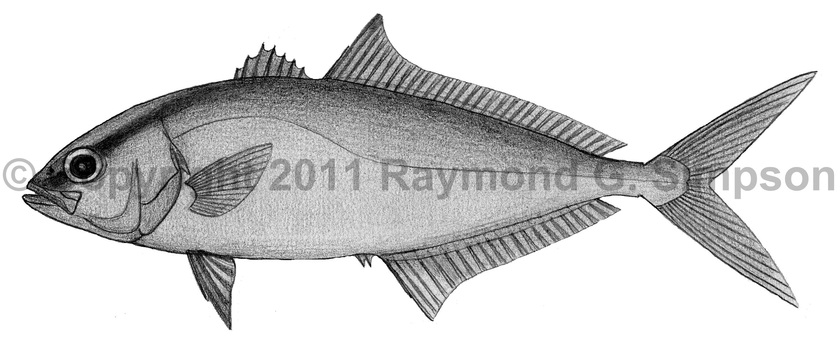
Common Name
Almaco Jack
Year Described
Cuvier & Valenciennes, 1833
Identification
Dorsal Fin: 7 spines in first dorsal (first reduced or embedded in large fish), followed by I, 27-33
Anal Fin: 2 separate spines (reduced and embedded in large fish), followed by I, 18-22
Pelvic Fin: I, 5
Gill Rakers: 18-25 total in fish >20cm; 6-9 upper, 18-20 lower; 24-29 total in fish <10cm
Vertebrae: 10 precaudal, 14 caudal
Elongate and moderately deep bodied. Jaw with very broad supramaxilla (larger than other species) extends to the anterior margin of eye. Teeth minute and present in both jaws. Spiny first dorsal much lower than second dorsal. Second dorsal base 1.5-1.6 times longer than anal fin base. Second dorsal and anal fin have raised anterior lobes (dorsal lobe 4.3-6.3 times in FL). Pelvic fins larger than pectoral fin. Lateral line with a shallow anterior arch and a straight posterior portion with no scutes. Caudal peduncle groove present. Body smooth with tiny cycloid scales. First anal pterygiophore straight in fish >10cm.
Color
Adults brown to blue-green dorsally grading to silvery-white on the belly. A dark stripe is often present from the eye to the dorsal fin base and a faint gold lateral stripe is often present from eye to tail. Dorsal, caudal, and anal fins dusky to yellowish brown with lighter distal margins. Anal fin lobe often with white anterior margin. Pelvic fin white with yellowish brown pigment or entirely dark. Pectoral fins yellowish to dusky. Juveniles pale with 6 dark bands on body and a conspicuous eye band. A seventh dark band on caudal peduncle. Fins dark to dusky.
Size
Usually from 55-80cm. Maximum size to 160cm.
Habitat
Oceanic or epibenthic offshore over deep waters.
Range
Massachusetts to Argentina, including Bermuda and the Caribbean islands
References
Smith-Vaniz, W.F. 2003. Carangidae (pp 1426-1468). In: Carpenter. 2003. The living marine resources of the Western Central Atlantic v. 3.